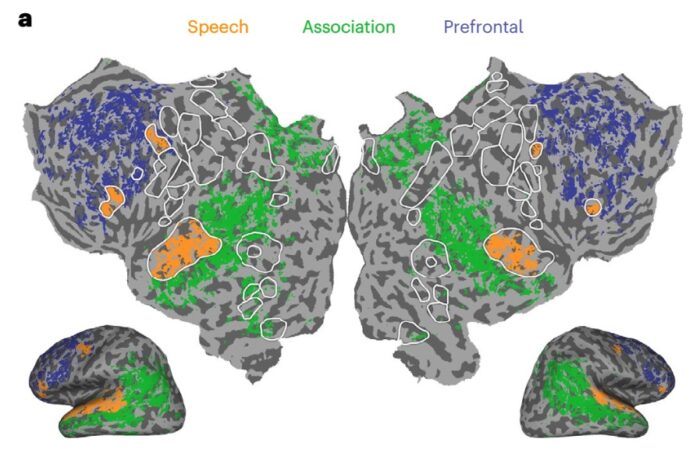May
02
2023
 This is pretty exciting neuroscience news – Semantic reconstruction of continuous language from non-invasive brain recordings. What this means is that researchers have been able to, sort of, decode the words that subjects were thinking of simply by reading their fMRI scan. They were able to accomplish this feat using a large language model AI, specifically GPT-1, an early version of Chat-GPT. It’s a great example of how these AI systems can be leveraged to aid research.
This is pretty exciting neuroscience news – Semantic reconstruction of continuous language from non-invasive brain recordings. What this means is that researchers have been able to, sort of, decode the words that subjects were thinking of simply by reading their fMRI scan. They were able to accomplish this feat using a large language model AI, specifically GPT-1, an early version of Chat-GPT. It’s a great example of how these AI systems can be leveraged to aid research.
This is the latest advance in an overall research goal of figuring out how to read brain activity and translate that activity into actual thoughts. Researchers started by picking some low-hanging fruit – determining what image a person was looking at by reading the pattern of activity in their visual cortex. This is relatively easy because the visual cortex actually maps to physical space, so if someone is looking at a giant letter E, that pattern of activity will appear in the cortex as well.
Moving to language has been tricky, because there is no physical mapping going on, just conceptual mapping. Efforts so far have relied upon high resolution EEG data from implanted electrodes. This research has also focused on single words or phrases, and often trying to pick one from among several known targets. This latest research represents three significant advances. The first is using a non-invasive technique to get the data, fMRI scan. The second is inferring full sentences and ideas, not just words. And the third is that the targets were open-ended, not picked from a limited set of choices. But let’s dig into some details, which are important.
Continue Reading »
May
01
2023
 I was interviewed recently for a Daily Beast article on recent research involving the Institute of Noetic Sciences (IONS). Overall the article is very good, and author Maddie Bender was fair and reasonable in how I was quoted. I can’t always take that as a given. No matter how careful you are, a lot can be done with the edit and perfectly reasonable statements can be framed in a positive or negative light. It all depends on what story the author is writing.
I was interviewed recently for a Daily Beast article on recent research involving the Institute of Noetic Sciences (IONS). Overall the article is very good, and author Maddie Bender was fair and reasonable in how I was quoted. I can’t always take that as a given. No matter how careful you are, a lot can be done with the edit and perfectly reasonable statements can be framed in a positive or negative light. It all depends on what story the author is writing.
In this case the story was about how fringe science and even pseudoscience can infiltrate mainstream academic institutions. There is a lot of nuance to this topic, because as with many such things there is a demarcation problem. As I have discussed many times before, for example, there is a demarcation problem between science and pseudoscience. There is no sharp line between the two, but a smooth transition. Much mainstream science can fall short in terms of rigorous methodology, and not all pseudoscience gets everything wrong. But that doesn’t mean there isn’t pseudoscience (that would be the false continuum logical fallacy) – get far enough to one end of the spectrum and you are in the realm of pseudoscience.
Academic institutions have another demarcation problem to deal with – academic freedom. This one is perhaps even trickier, because it is critically important that academics have the intellectual freedom to explore new and unpopular ideas, even ones that may be considered “dangerous”. As I have also written before, I have no problem with researchers exploring new ideas, fringe ideas, even weird ideas, as long as they are being true to scientific philosophy and methodology, and not making claims that go beyond the evidence. Further, this means that pseudoscience is not an area of study, but a set of behaviors. You can be doing pseudoscience when studying mainstream claims, or rigorous science when studying the paranormal. It’s the method and logic that matter. For example, Richard Wiseman has done rigorous investigations of the paranormal. I would never call him a pseudoscientist.
One of the core features of doing pseudoscience is assuming that your claim (paranormal or otherwise) is true and then working backwards from that assumption. This leads to performing research to show that the phenomenon is true, or perhaps how it works, but not doing research capable of determine if it is true. This brings us back to IONS and the Daily Beast article. The article focuses on neuroscientist Spiro Pantazatos and his collaboration with IONS, looking for brain regions that might correlate with specific paranormal phenomena. My problem with this research is that is assumes various paranormal phenomena are real, when that has not been scientifically established. In fact, as I point out in the article, we have over a century of research which has failed to demonstrate psi phenomena (ESP, clairvoyance, telekenesis, etc.) to point to. This is not some new idea that has never been explored.
Continue Reading »
 This is pretty exciting neuroscience news – Semantic reconstruction of continuous language from non-invasive brain recordings. What this means is that researchers have been able to, sort of, decode the words that subjects were thinking of simply by reading their fMRI scan. They were able to accomplish this feat using a large language model AI, specifically GPT-1, an early version of Chat-GPT. It’s a great example of how these AI systems can be leveraged to aid research.
This is pretty exciting neuroscience news – Semantic reconstruction of continuous language from non-invasive brain recordings. What this means is that researchers have been able to, sort of, decode the words that subjects were thinking of simply by reading their fMRI scan. They were able to accomplish this feat using a large language model AI, specifically GPT-1, an early version of Chat-GPT. It’s a great example of how these AI systems can be leveraged to aid research.
 I was interviewed recently for
I was interviewed recently for 




